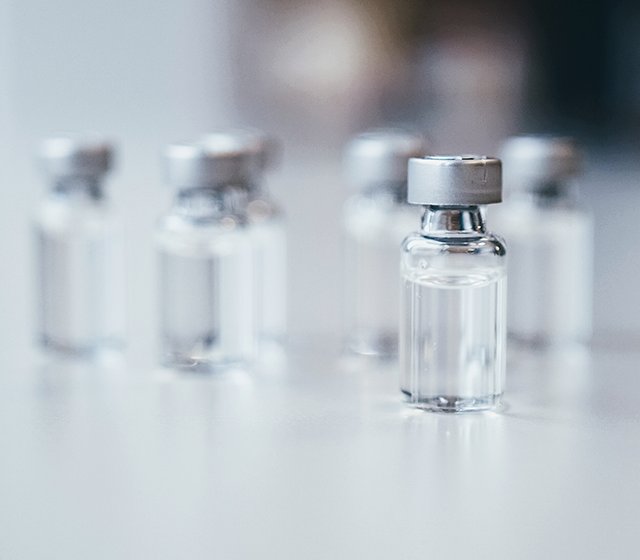COVID-19
COVID-19 drug development
To date, there is no curative specific treatment for COVID-19. Even if validation processes and trials are accelerated in case of pandemic and health crisis, the release on the market of new drugs can take several years. Consequently repurposing existing drugs seems a better and faster approach.
Drug development vs repurposing
There is no specific drug available on the market to treat post-COVID-19 infection and many laboratories around the world are currently busy finding potential molecule candidates that could block the virus life cycle at different stages. As the virus may infect various organs inside the human body, multidrug treatment could be a better strategy to cure the disease efficiently. (1)
However new drug development generally takes a few years. Therefore, biotech and pharma companies put their interest in new technology development to produce medicines faster with reduced costs of goods or opt for existing drug repurposing to deliver on the market an efficient and safe treatment against COVID-19. Candidates among existing antivirals, inhibitors, antibiotics and much more others already entered late clinical trial phases. (1)
Free ACE2 - drug repurposing
A good example of repurposing is the use of free ACE2 which undergone clinical trials for the treatment of acute respiratory distress syndrome. Recombinant soluble ACE2 could compete with the host cell ACE2 membrane receptor, inhibit the attachment of the SARS-CoV-2 virus to the receptor that could continue to work properly. Experimental studies have been shown that recombinant soluble ACE2 significantly blocks the virus infection.(1)
Neutralizing antibodies from Llama as therapeutics
In addition to conventional two-chain-structured antibodies, Camelids produce single-heavy-chain Ab with the smallest naturally-occurring antigen binding domain, the VHH Fragment.
Due to their small sizes (~15kDa), high tissue penetration, and stability, VHH antibody fragments can be used in therapy to bind epitopes that are hidden and deliver drugs on a specific site.
In the COVID-19 context, Jiangdong Huo et al. identified a neutralizing Llama nanobody that interacts with a high affinity to the receptor-binding domain (RBD) of the spike protein (Protein S) of SARS-CoV-2. This interaction blocks the bounding between Protein S and the human ACE2 receptor preventing the virus entry into the host cell. (2)
VHH nanobodies are considered a promising treatment for COVID-19 blocking the virus in its life cycle.
COVID19 Drug development
and manufacturing
We manufacture drugs for clinical trial and commercial material for all major markets according to FDA, EMA, and PMDA requirements. We offer GMP biomanufacturing of Plasmid DNA, recombinant proteins, and protein conjugates. We also produce GMP therapeutic oligonucleotides by chemical synthesis and in vitro transcribed RNA (IVT-RNA) by enzymatic production.
Choose your weapons
We produce GMP Plasmid DNA for starting material, clinical trial, and commercial applications since 2004. We have significant experience and expertise in the large-scale production of plasmid DNA for various uses.
We develop processes and manufacture GMP recombinant proteins and chemically modified recombinant proteins for clinical trial and commercial uses. All GMP material is produced in accordance to US, EU and Japanese regulatory requirements for sterile injectable products.
We have experience in the production of numerous antibody fragment formats (VHH, scFv, Fab, diabody, and bispecific tandem scFv) in E.coli or P.pastoris.
We offer process development and GMP manufacturing of In vitro transcribed RNA (IVT-RNA) API for use in Tox studies and Human clinical trials.
We produce pre-clinical and GMP therapeutic oligonucleotides in ISO 8 & 7 classified cleanrooms respectively. We frequently produce siRNA, Antisense, Aptamer, CpG oligonucleotides among others.
SARS-CoV-2 related subjects
References
1) Drugs targeting various stages of the SARS-CoV-2 life cycle: Exploring promising drugs for the treatment of Covid-19.
Ramarao Poduri, Gaurav Joshi, Gowraganahalli Jagadeesh.
Cellular Signalling 74 (2020) 109721 – DOI: 1016/j.cellsig.2020.109721
2) Neutralizing nanobodies bind SARS-CoV-2 spike RBD and block interaction with ACE2.
Jiangdong Huo et al.
Nature Structural & Molecular Biology volume 27, pages846–854(2020) - DOI:10.1038/s41594-020-0469-6





